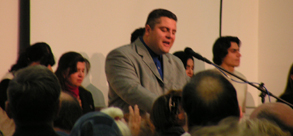Five Services in a Day
 From the largest evangelical church in Bulgaria, we traveled to five small regional village congregations. The change was the least to say drastic. We left behind the large, two million people metropolis of Sofia and quickly moved East crossing almost the entire country of Bulgaria on its long side. Moving at a fast pace, we arrived to our destination three hours later and began preparing for a day of ministry.
From the largest evangelical church in Bulgaria, we traveled to five small regional village congregations. The change was the least to say drastic. We left behind the large, two million people metropolis of Sofia and quickly moved East crossing almost the entire country of Bulgaria on its long side. Moving at a fast pace, we arrived to our destination three hours later and began preparing for a day of ministry.
The day started about 7 a.m. with prayer. The team assembled around 9:30 a.m. and began the daylong trip. The five churches on our schedule were located in a circle rout with 15-30 minutes of traveling between them. They were much smaller than the Central Church of God congregation, which has close to 1,000 members. Nevertheless, the people received us with the same joy and the services began.
Some of the congregations rent small auditoriums from the villages and others meet at a designated home with varying number of attendees. Many of the regular members have been pressed to leave Bulgaria and work in another country. One lady had just returned from such trip to Italy and attended one of the services.
We held five meetings from 10 a.m. to 3 p.m. traveling between each service to the next destination. This rout is one of four similar ones, which our team on location performs weekly. The heavily damaged roads, bad weather and limited resources add up a significant difficulty to the trip. The main problem, however, remains the ongoing economical crises, which have become an unseparatable part of the Bulgarian postcommunist reality. It constantly demotivates the people, crashes their self-esteem and forces them to live without the realization of their dreams. In actuality, fifteen years after the fall of the Berlin Wall, the large majority of Bulgarian people still live in poverty and with a slavery mentality. Fortunately, the revival among Bulgarian evangelicals has provided an atmosphere of expressed Bulgarian identity and applied Biblical reimagination.








Comments